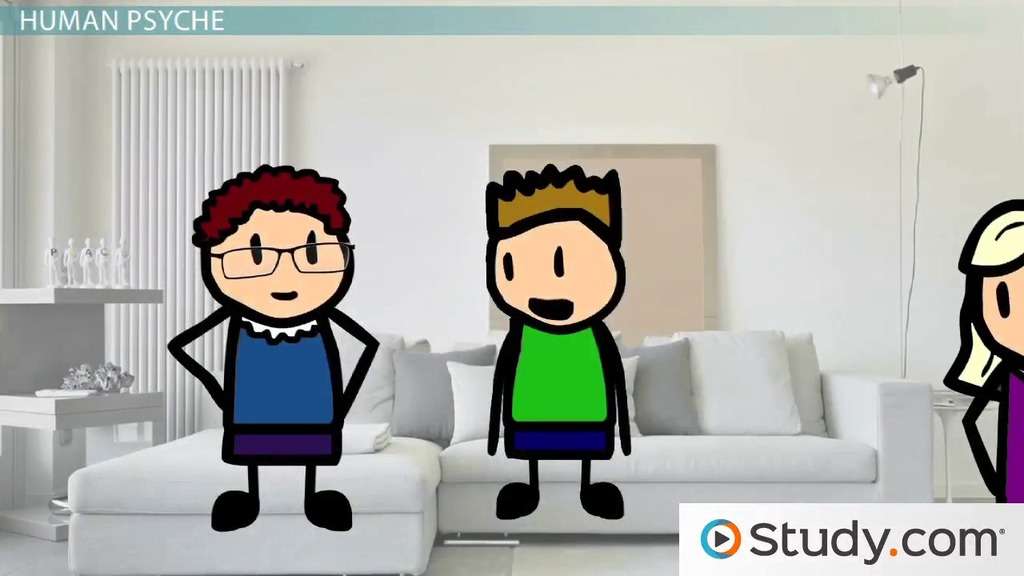Personality Theory
In his theory of personality, Carl Jung distinguishes two different attitude types: Introverts, which are those people who receive stimulation from within, and extroverts, which are those who receive their stimulation from the environment.
Introverts can be perceived as withdrawn or shy, but they are more defined as those who get their energy from being alone and being able to recharge through less stimulating activities, whereas extroverts get their energy from being around other people and engaging in stimulating activities. For example, Donna is an extrovert. She loves to go out on adventures with lots of people and see exciting new things. Her friend David, though, is the opposite. Given the choice, he’d rather read a book on his couch than go skydiving with Donna. David is an introvert.
Jung also separates introverts and extroverts into four subtypes according to the functions that control the way they perceive the world. Both introverts and extroverts can be any of these subtypes, so there are eight possible personality types. These four functions are:
1. Thinking
Applying reasoning to the situations and environments you encounter. For example, David likes to think things through and consider all the pros and cons before he makes a decision about anything.
2. Feeling
Applying subjective, personal assessment to the situations and environments you encounter. Unlike David, Donna relies on her feelings to tell her how to make a decision. If something feels good, she goes for it; if it doesn’t, she avoids it.
3. Sensation
Applying aesthetic value to the situations and environments you encounter. For example, when deciding how to arrange his living room, David tries to make things very symmetrical. If there’s a chair on one side of the room, he has to put the same chair on the other side of the room to balance it. This symmetry makes the room look nice.
4. Intuition
Using your unconscious or the mystical to understand your experiences. For example, Donna thinks David is arranging his furniture all wrong. Donna believes it is important to arrange furniture more spaced apart in order to bring about positive energy.
Human Psyche
The human psyche is the whole mind, including the conscious and the unconscious. Jung’s theory states that each person’s psyche is comprised of three components:
1. Ego
The hub of consciousness that forms all unrepressed perceptions, thoughts, feelings and memories. When Donna walks into a room, her ego perceives the color of the walls, the people in the room and what they’re doing and the song playing in the background. But, the ego can only hold a select amount of information and the remaining data sinks into the unconscious.
2. Personal unconscious
The experiences and memories unique to the individual that are not currently in, but are readily available to, the conscious mind. For example, maybe Donna feels uncomfortable in the room where she just walked. She doesn’t like it, but she’s not sure why. It just gives her a bad feeling. Perhaps it’s because the walls are the same color as the hospital room where her grandmother died. She doesn’t consciously associate the room with her grandmother dying, but she has bad feelings because her personal unconscious is at work.
3. Collective unconscious
The universal experiences and memories shared by all humans – the blueprints for life that allow us to adapt and survive. The collective unconscious is further comprised of archetypes, or modes of thought that belong to all of humanity. The hero and villain, son and father, strong and weak – these are all archetypes. Donna also feels uneasy in the room because the decorations are almost all red. She associates red with anger and aggression, and blue with serenity and peace, like many people do. This is an example of archetypes.
Dream Analysis
It was during his research into dream analysis that Jung parted ways with Freud; he disagreed with Freud’s heavy emphasis on sexual motivation in dreams. Additionally, Freud believed that the unconscious mind used dreams to hide repressed desires from the conscious, whereas Jung believed that the unconscious mind used dreams to reveal suppressed desires to the conscious.
According to Jung’s theory, as a window to the unconscious, dreams serve to help you solve problems in your waking life and become a more whole person. Dreams are formed by the two parts of the unconscious – the personal and the collective. They can be analyzed by interpreting the archetypes presented by the collective unconscious; however, the symbolism contained in dreams is specific to the individual’s life. Therefore, meaning cannot be broadly ascribed to a symbol. For example, a dream about falling might mean one person’s career is on the wrong track, while the same dream might signify repressed sexual desires for another person.
Lesson Summary
Jungian psychology, also called analytical psychology, is a branch of psychology founded by Carl Jung. He studied personalities and clustered people into introverts and extroverts. Further, he said that introverts and extroverts could view the world through thinking, feeling, sensation or intuition. Jung believed that the human psyche had three parts: the ego, personal unconscious and collective unconscious. Finally, his dream analysis was broader than Freud’s, as Jung believed that symbols could mean different things to different people.
Learning Outcomes
Upon completion of this lesson, you should be able to:
- Understand Carl Jung’s contributions to psychology
- Differentiate between introverts and extroverts
- Name and summarize the four personality subtypes and the three components of the human psyche
- Explain Jung’s dream analysis and how it differed from Freud’s
Carl Jung’s Theories: Archetypes, & The Collective Unconscious
By Dr. Saul McLeod, published 2018
Carl Jung was an early supporter of Freud because of their shared interest in the unconscious. He was an active member of the Vienna Psychoanalytic Society (formerly known as the Wednesday Psychological Society).
When the International Psychoanalytical Association formed in 1910 Jung became president at the request of Freud.

Wednesday Psychological Society
However in 1912 while on a lecture tour of America Jung publicly criticized Freud’s theory of the Oedipus complex and his emphasis on infantile sexuality. The following year this led to an irrevocable split between them and Jung went on to develop his own version of psychoanalytic theory.
Most of Jung’s assumptions of his analytical psychology reflect his theoretical differences with Freud. For example, while Jung agreed with Freud that a person’s past and childhood experiences determined future behavior, he also believed that we are shaped by our future (aspirations) too.
Differences between Jung and Freud

Theory of the Libido
Jung (1948) disagreed with Freud regarding the role of sexuality. He believed the libido was not just sexual energy, but instead generalized psychic energy.
For Jung, the purpose of psychic energy was to motivate the individual in a number of important ways, including spiritually, intellectually, and creatively. It was also an individual’s motivational source for seeking pleasure and reducing conflict
Theory of the Unconscious
Like Freud (and Erikson) Jung regarded the psyche as made up of a number of separate but interacting systems. The three main ones were the ego, the personal unconscious, and the collective unconscious.
According to Jung, the ego represents the conscious mind as it comprises the thoughts, memories, and emotions a person is aware of. The ego is largely responsible for feelings of identity and continuity.
Like Freud, Jung (1921, 1933) emphasized the importance of the unconscious in relation to personality. However, he proposed that the unconscious consists of two layers.
The first layer called the personal unconscious is essentially the same as Freud’s version of the unconscious. The personal unconscious contains temporality forgotten information and well as repressed memories.
Jung (1933) outlined an important feature of the personal unconscious called complexes. A complex is a collection of thoughts, feelings, attitudes, and memories that focus on a single concept.
The more elements attached to the complex, the greater its influence on the individual. Jung also believed that the personal unconscious was much nearer the surface than Freud suggested and Jungian therapy is less concerned with repressed childhood experiences. It is the present and the future, which in his view was the key to both the analysis of neurosis and its treatment.
The Collective Unconscious
However, by far the most important difference between Jung and Freud is Jung’s notion of the collective (or transpersonal) unconscious. This is his most original and controversial contribution to personality theory.
The collective unconscious is a universal version of the personal unconscious, holding mental patterns, ormemory traces, which are shared with other members of human species (Jung, 1928). These ancestral memories, which Jung calledarchetypes, are represented by universal themes in various cultures, as expressed through literature, art, and dreams.
‘The form of the world into which [a person] is born is already inborn in him, as a virtual image’ (Jung, 1953, p. 188).
According to Jung, the human mind has innate characteristics “imprinted” on it as a result of evolution. These universal predispositions stem from our ancestral past. Fear of the dark, or of snakes and spiders might be examples, and it is interesting that this idea has recently been revived in the theory of prepared conditioning (Seligman, 1971).
However, more important than isolated tendencies are those aspects of the collective unconscious that have developed into separate sub-systems of the personality. Jung (1947) called these ancestral memories and images archetypes.
Jungian Archetypes
Jungian archetypes are defined as images and themes that derive from the collective unconscious, as proposed by Carl Jung. Archetypes have universal meanings across cultures and may show up in dreams, literature, art or religion.
Jungian archetypes are defined as images and themes that derive from the collective unconscious, as proposed by Carl Jung. Archetypes have universal meanings across cultures and may show up in dreams, literature, art or religion.
Jung (1947) believes symbols from different cultures are often very similar because they have emerged from archetypes shared by the whole human race which are part of our collective unconscious.
For Jung, our primitive past becomes the basis of the human psyche, directing and influencing present behavior. Jung claimed to identify a large number of archetypes but paid special attention to four.
Jung labeled these archetypes the Self, the Persona, the Shadow and the Anima/Animus.
The Persona
The persona (or mask) is the outward face we present to the world. It conceals our real self and Jung describes it as the “conformity” archetype. This is the public face or role a person presents to others as someone different to who we really are (like an actor).
The Anima/Animus
Another archetype is the anima/animus. The “anima/animus” is the mirror image of our biological sex, that is, the unconscious feminine side in males and the masculine tendencies in women.
Each sex manifests attitudes and behavior of the other by virtue of centuries of living together. The psyche of a woman contains masculine aspects (the animus archetype), and the psyche of a man contains feminine aspects (the anima archetype).
The Shadow
Next is the shadow. This is the animal side of our personality (like the id in Freud). It is the source of both our creative and destructive energies. In line with evolutionary theory, it may be that Jung’s archetypes reflect predispositions that once had survival value.
The Self
Finally, there is the self which provides a sense of unity in experience. For Jung, the ultimate aim of every individual is to achieve a state of selfhood (similar to self-actualisation), and in this respect, Jung (like Erikson) is moving in the direction of a more humanist orientation.
That was certainly Jung’s belief and in his book “The Undiscovered Self” he argued that many of the problems of modern life are caused by “man’s progressive alienation from his instinctual foundation.” One aspect of this is his views on the significance of the anima and the animus.
Jung argues that these archetypes are products of the collective experience of men and women living together. However, in modern Western civilization men are discouraged from living their feminine side and women from expressing masculine tendencies. For Jung, the result was that the full psychological development both sexes was undermined.
Together with the prevailing patriarchal culture of Western civilization this has led to the devaluation of feminine qualities altogether, and the predominance of the persona (the mask) has elevated insincerity to a way of life which goes unquestioned by millions in their everyday life.
Critical Evaluation
Jung’s (1947, 1948) ideas have not been as popular as Freud’s. This might be because he did not write for the layman and as such his ideas were not a greatly disseminated as Freud’s. It may also be because his ideas were a little more mystical and obscure, and less clearly explained.
On the whole modern psychology has not viewed Jung’s theory of archetypes kindly. Ernest Jones (Freud’s biographer) tells that Jung “descended into a pseudo-philosophy out of which he never emerged” and to many his ideas look more like New Age mystical speculation than a scientific contribution to psychology.
However, while Jung’s research into ancient myths and legends, his interest in astrology and fascination with Eastern religion can be seen in that light, it is also worth remembering that the images he was writing about have, as a matter of historical fact, exerted an enduring hold on the human mind.
Furthermore, Jung himself argues that the constant recurrence of symbols from mythology in personal therapy and in the fantasies of psychotics support the idea of an innate collective cultural residue. In line with evolutionary theory it may be that Jung’s archetypes reflect predispositions that once had survival value.
Jung proposed that human responses to archetypes are similar to instinctual responses in animals. One criticism of Jung is that there is no evidence that archetypes are biologically based or similar to animal instincts (Roesler, 2012).
Rather than being seen as purely biological, more recent research suggests that archetypes emerge directly from our experiences and are reflections of linguistic or cultural characteristics (Young-Eisendrath, 1995).
However, Jung’s work has also contributed to mainstream psychology in at least one significant respect. He was the first to distinguish the two major attitudes or orientations of personality – extroversion and introversion (Jung, 1923). He also identified four basic functions (thinking, feeling, sensing, and intuiting) which in a cross-classification yield eight pure personality types.
Psychologists like Hans Eysenck and Raymond Cattell have subsequently built upon this. As well as being a cultural icon for generations of psychology undergraduates Jung, therefore, put forward ideas which were important to the development of modern personality theory.
How to reference this article:
How to reference this article:
McLeod, S. A. (2018, May 21). Carl jung. Simply Psychology. www.simplypsychology.org/carl-jung.html
APA Style References
Jung, C. G. (1921). Psychological types. The collected works of CG Jung, Vol. 6 Bollingen Series XX.
Jung, C. G. (1923). On The Relation Of Analytical Psychology To Poetic Art 1. British Journal of Medical Psychology, 3(3), 213-231.
Jung, C. G. (1928). Contributions to analytical psychology. New York: Harcourt Brace
Jung, C. G. (1933). Modern man in search of his soul.
Jung, C. G. (1947). On the Nature of the Psyche. London: Ark Paperbacks.
Jung, C. G. (1948). The phenomenology of the spirit in fairy tales. The Archetypes and the Collective Unconscious, 9(Part 1), 207-254.
Jung, C. G. (1953). Collected works. Vol. 12. Psychology and alchemy.
Roesler, C. (2012). Are archetypes transmitted more by culture than biology? Questions arising from conceptualizations of the archetype. Journal of Analytical Psychology, 57(2), 223-246.
Seligman, M. E. P. (1971). Preparedness and phobias. Behavior Therapy, 2(3), 307-20.
Young-Eisendrath, P. (1995). Struggling with jung: The value of uncertainty. Psychological Perspectives, 31(1), 46-54.
How to reference this article:
How to reference this article:
McLeod, S. A. (2018, May 21). Carl jung. Simply Psychology. www.simplypsychology.org/carl-jung.html
Home
|
About Us
|
Privacy Policy
|
Advertise
|
Contact Us
Back to top
Simply Psychology’s content is for informational and educational purposes only. Our website is not intended to be a substitute for professional medical advice, diagnosis, or treatment.
© Simply Scholar Ltd – All rights reserved



